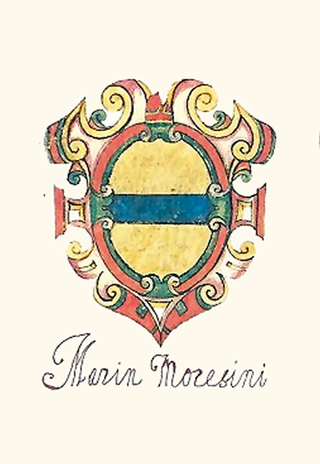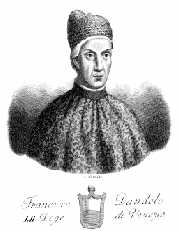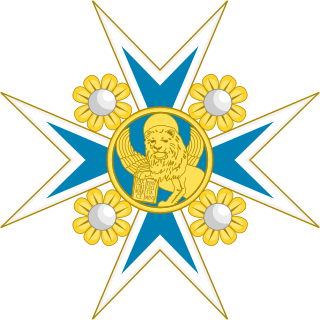
Leonardo Loredan was a Venetian nobleman and statesman who reigned as the 75th Doge of Venice from 1501 until his death in 1521. As a wartime ruler, he was one of the most important doges in the history of Venice. In the dramatic events of the early 16th century, Loredan's Machiavellian plots and cunning political manoeuvres against the League of Cambrai, the Ottomans, the Mamluks, the Pope, the Republic of Genoa, the Holy Roman Empire, the French, the Egyptians and the Portuguese saved Venice from downfall.

The Council of Ten, or simply the Ten, was from 1310 to 1797 one of the major governing bodies of the Republic of Venice. Elections took place annually and the Council of Ten had the power to impose punishments upon patricians. The Council of Ten had a broad jurisdictional mandate over matters of state security. The Council of Ten and the Full College constituted the inner circle of oligarchical patricians who effectively ruled the Republic of Venice.

The Contarini is one of the founding families of Venice and one of the oldest families of the Italian Nobility. In total eight Doges to the Republic of Venice emerged from this family, as well as 44 Procurators of San Marco, numerous ambassadors, diplomats and other notables. Among the ruling families of the republic, they held the most seats in the Great Council of Venice from the period before the Serrata del Maggior Consiglio when Councillors were elected annually to the end of the republic in 1797. The Contarini claimed to be of Roman origin through their patrilineal descendance of the Aurelii Cottae, a branch of the Roman family Aurelia, and traditionally trace their lineage back to Gaius Aurelius Cotta, consul of the Roman Republic in 252 BC and 248 BC.

Pietro Ottoboni was an Italian cardinal and grandnephew of Pope Alexander VIII, who was also born Pietro Ottoboni. He is remembered especially as a great patron of music and art. Ottoboni was the last person to hold the curial office of cardinal-nephew, which was abolished by Alexander's successor, Pope Innocent XII, in 1692. Ottoboni '"loved pomp, prodigality, and sensual pleasure, but was in the same time kind, ready to serve, and charitable."

Otto Orseolo was the Doge of Venice from 1008 to 1026. He was the third son of Doge Pietro II of the House of Orseolo, and Maria Candiano, whom he succeeded at the age of sixteen, becoming the youngest doge in Venetian history.

Domenico Morosini was the thirty-seventh doge of the Republic of Venice, reigning from 1148 until his death in 1156.

San Nicolò al Lido refers to both the San Nicolò Church and most importantly to its annexed Monastery of San Nicolò located in Venice, northern Italy. The two Catholic institutions are located in the northern part of the Lido di Venezia and house the relics of Saint Nicholas, patron of sailors. From this church, the traditional thanksgiving Mass of the Sposalizio del Mare is celebrated. The complex houses monks of the Franciscan order.

Francesco Dandolo was the 52nd Doge of Venice. He ruled from 1329 to 1339. During his reign Venice began its policy of extending its territory on the Italian mainland.

The House of Loredan is a Venetian noble family of supposed ancient Roman origin, which has played a significant role in shaping the history of the Mediterranean world. A political dynasty, the family has throughout the centuries produced a number of famous personalities: doges, statesmen, magnates, financiers, diplomats, procurators, military commanders, naval captains, church dignitaries, and writers.

Nicolò Donà or Nicolò Donato was the 93rd Doge of Venice, reigning for little more than a month, from his election on 5 April 1618 until his death.

Francesco Erizzo was the 98th Doge of Venice, reigning from his election on 10 April 1631 until his death fifteen years later. His reign is particularly notable because the last year of his reign saw the beginning of a war with the Ottoman Empire for control of Crete that would last for 24 years and dominate the geopolitics of the Mediterranean.
This article presents a detailed timeline of the history of the Republic of Venice from its legendary foundation to its collapse under the efforts of Napoleon.

The Order of Saint Mark was the sole order of chivalry of the Republic of Venice. It was named in honour of Venice's patron saint, Mark the Evangelist.

The House of Tron was a noble family of Venice whose most prominent member, Nicolò Tron, served as the Doge of Venice from 1471 to 1473. Other members of the family served as procurators, senators, generals and ambassadors of the Venetian Republic.
The savi del Consiglio dei Pregadi, also known as the savi grandi, were senior magistrates of the Republic of Venice.

The Full College was the main executive body of the Republic of Venice, overseeing day-to-day governance and preparing the agenda for the Venetian Senate.

The Provveditore Generale da Mar was the most senior peacetime office in the Venetian navy and in charge of governing the Venetian overseas empire.

Nicolò Tron was an Italian politician, businessman and agronomist, citizen of the Republic of Venice.
The Venetian Inquisition, formally the Holy Office, was the tribunal established jointly by the Venetian government and the Catholic Church to repress heresy throughout the Republic of Venice. The inquisition also intervened in cases of sacrilege, apostasy, prohibited books, superstition, and witchcraft. It was established in the 16th-century and was abolished in 1797.
This is an alphabetical index of people, places, things, and concepts related to or originating from the Republic of Venice. Feel free to add more, and create missing pages.

















